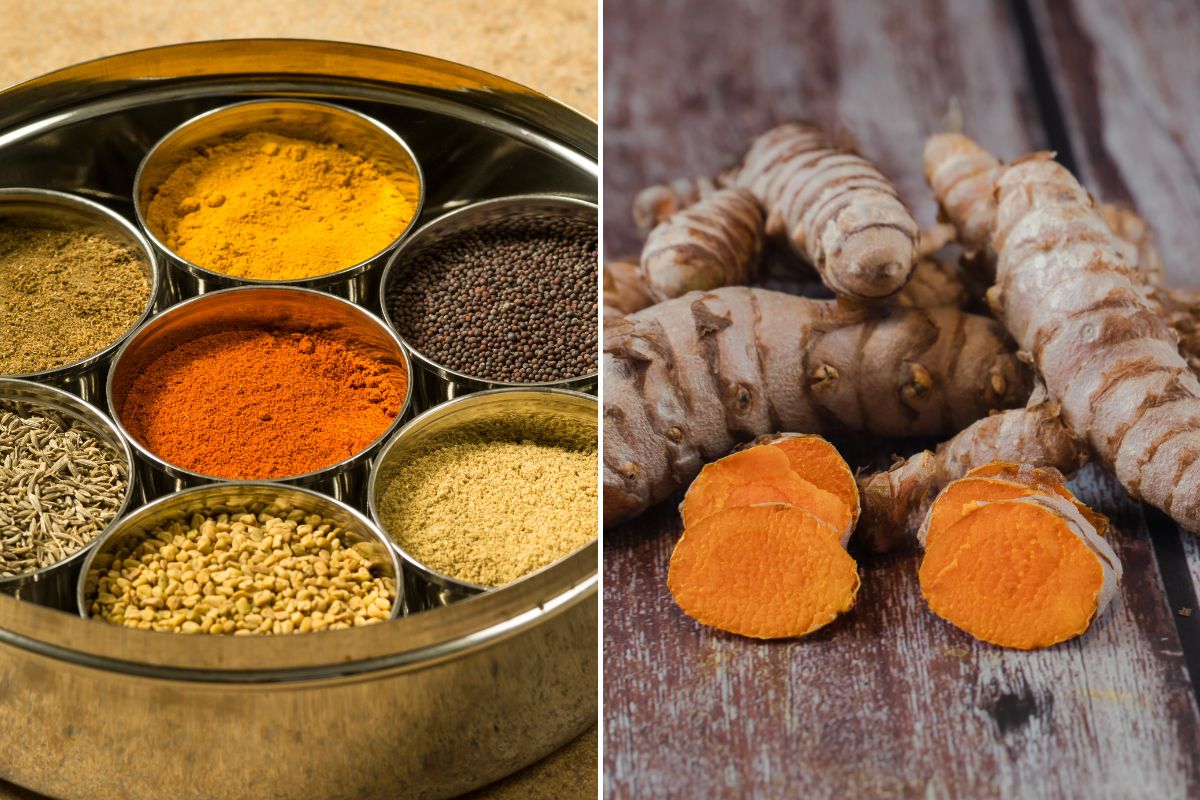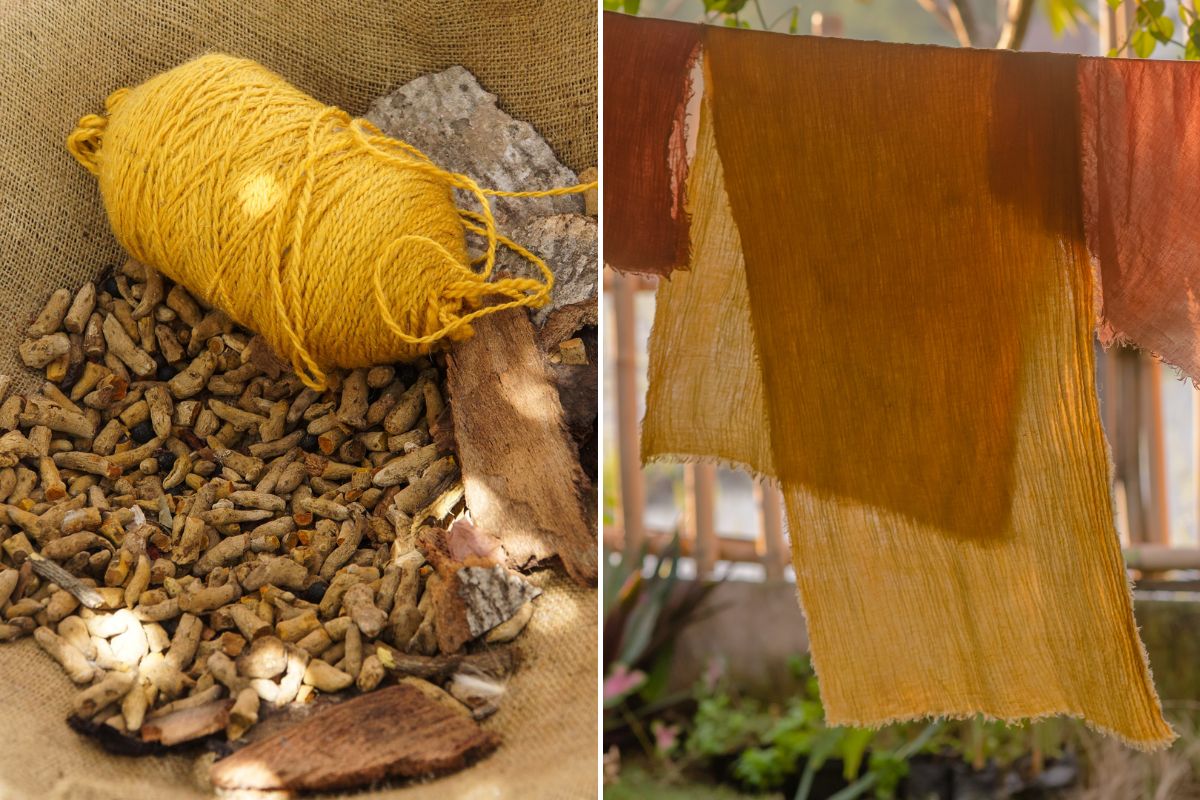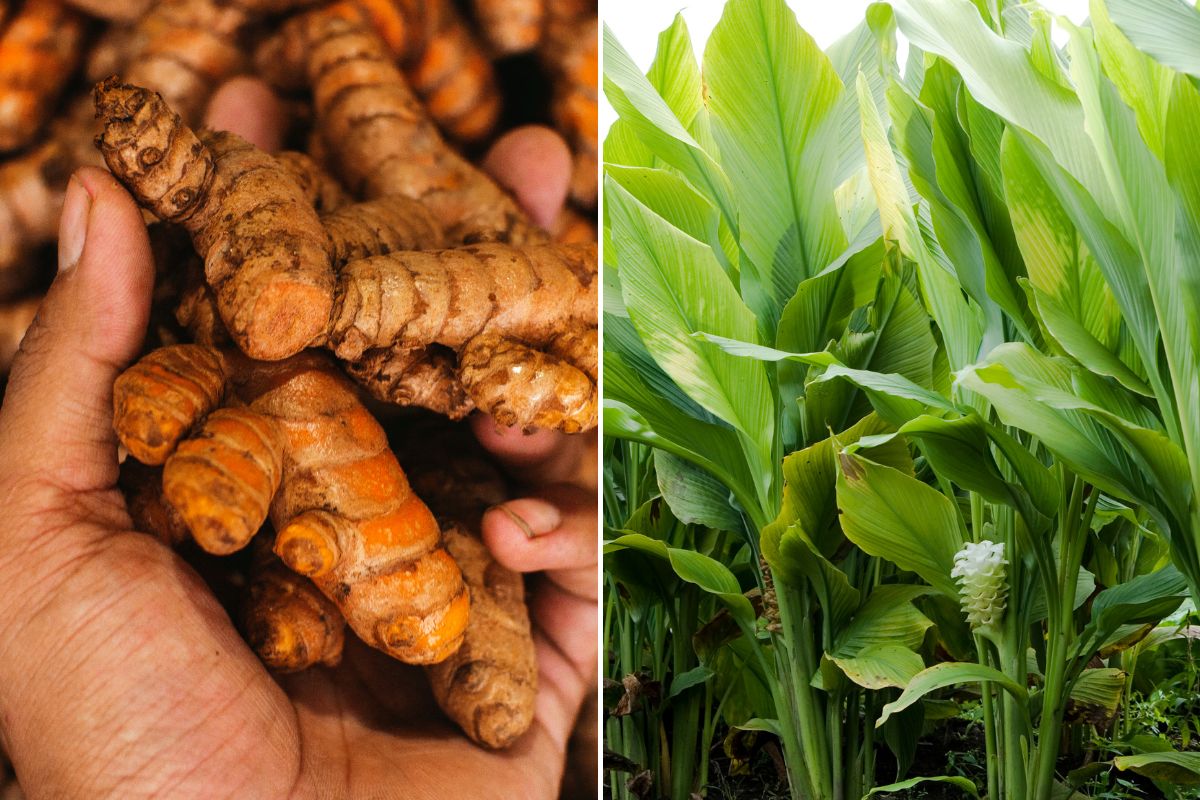Turmeric, Curcuma longa, is an attractive perennial plant in the same family as ginger. Like ginger it originates in Southeast Asia, and has both ornamental and edible uses.
The lush, flat, bright green leaves and attractive spikes of greenish cream flowers can be used to create a tropical feel in a garden or courtyard, and the edible rhizomes can be used, either fresh or dried, in a variety of dishes. How to plant, grow and harvest turmeric can be found in this handy grow guide.
The rhizomes, commonly known as 'fingers', outwardly resemble ginger but are rounder in cross section, are about 1.5cm in diameter, and are a deep orange-yellow colour. This deep colour comes from curcumin, a bright yellow chemical compound found in turmeric, which is used as both a flavouring and colourant in food, as well as a clothing and fabric dye.
This article looks at how turmeric is used when preparing food, and as a fabric dye, and because it can stain anything it comes into contact with, you'll find some handy tips on how to remove those pesky stains as well!
Turmeric in Cooking
Turmeric rhizomes can be used fresh, or they can be boiled in water and dried before being ground into a deep yellow-orange powder.
Turmeric is commonly used as a colouring and flavouring agent in many Asian cuisines, and is often used to colour rice and other foodstuffs instead of using the more expensive saffron.
It is a key component of various curry powders, masalas and spice blends, and lends both colour and flavour to dill pickles and condiments like American mustard.
1. What Does Turmeric Taste Like
Turmeric has a warm, bitter, astringent and peppery-earthy flavour, with a mustard-like aroma. It is a strongly flavoured spice, so a little goes a long way.
It is flavoursome on its own and has the ability to enhance the flavour of other spices. Black pepper is often used in conjunction with turmeric as it adds a heat that counterbalances the astringency of turmeric.
2. Fresh Turmeric
Like ginger root, fresh turmeric can be stored short-term in the fridge or freezer. Keep it in a paper bag in the fridge for 2-3 weeks, or in a resealable plastic bag in the freezer for up to a year.
Fresh turmeric root can be finely grated like ginger and added to various dishes. Take care when peeling or grating turmeric as it can stain your hands. The colour can be difficult to remove, so use gloves and rinse your hands and cutting board as soon as possible after handling turmeric to reduce the chance of the stain setting.
If you are using fresh turmeric in a recipe instead of turmeric powder, then you should use about three times more fresh turmeric than powdered turmeric. This is because powdered turmeric is more concentrated than fresh turmeric. A good rule of thumb is: 1 teaspoon of ground dried turmeric = 2½ teaspoons of fresh turmeric.
 Use turmeric fingers fresh, or dried and ground as part of a spice mix
Use turmeric fingers fresh, or dried and ground as part of a spice mix
3. Dried Turmeric and Turmeric Powder
Ground dried turmeric has a bright yellow-orange colour and is best stored in a cool dark place. It will however begin to lose its pungency after about a year, so if you don't use it regularly, then only buy it in small quantities, or only grind enough for a few months at a time.
Turmeric powder can be used to make a delicious hot tea or beverage by stirring ½ teaspoon of ground turmeric into ½ to 1 teaspoon of pure maple syrup or honey. Then add 1 cup of boiling water, a few grinds of black pepper, and stir to combine. You could also add some ginger, a squeeze of lemon, or some milk if that is your preference.
Golden milk, also known as haldi doodh or turmeric milk, is a comforting milky drink made with turmeric. It is a good idea to go lightly with the turmeric otherwise it can become too bitter and taste rather medicinal. Other spices such as black pepper, cardamom, ginger, and cinnamon can be added to add extra flavour and warmth. Golden milk can be made as follows:
- 2½ cups milk (regular milk, or almond or other plant-based milks)
- ¾ teaspoon ground turmeric
- 4 green cardamom pods slightly crushed
- ½ inch piece of ginger cut into thin slices
- 5-6 whole black peppercorns
- 1 inch cinnamon stick
- 1 tablespoon sugar, maple syrup, honey, or other sweetener - adjust to taste
- cinnamon or cardamom powder to serve (optional)
Warm the milk in a pan over medium heat. After a minute or so when the milk is lukewarm, add the turmeric powder. Then add the cardamom, ginger, peppercorns and cinnamon stick. Add the sweetener, whisk it all together and bring to a low simmer for 5 minutes. It doesn't need to boil but must be hot. Remove the pan from the heat, cover it with a plate or lid and let it sit for another 5 minutes to allow the flavour to develop. Strain into cups and sprinkle with cardamom or cinnamon powder before serving.
 Golden milk and turmeric tea
Golden milk and turmeric tea
Turmeric as a Food Colouring and Fabric Dye
1. Colouring Food
You can use both fresh or powdered turmeric to colour various foodstuffs.
To use fresh turmeric, peel and chop up a fresh root. Then blitz it in a blender with a splash of water, or grind it using a mortar and pestle, to make a runny paste. Pass the mixture through a sieve, and set it aside at room temperature for a few hours so the colour can intensify. Add a couple teaspoons of this liquid to doughs and batters to give a sunny yellow colour to baked goods.
You can also use powdered turmeric as is, simply by stirring the powder directly into food. Alternatively, make a more traditional food dye by dissolving 1 teaspoon turmeric in ½ cup water, bringing it to a boil and allowing it to boil until it is reduced by half. Use a small quantity of this liquid to colour things yellow, or use more to get a deeper orange colour.
2. Dyeing Fabric
Turmeric is a natural dye, and while it can stain and dye fabric and clothing, it's what's called a fugitive dye. This means that the dye doesn’t chemically bond with the cloth fibres or permeate their structure. Instead, it sticks to the outside of the fibres, so the colour will fade over time (anywhere from one day to 8 months) especially if exposed to sunlight. As with other natural dyes, the colour may also never fully wash out after consecutive washes but it will fade to a lighter yellow.
Dyeing with turmeric can be as simple as bringing water to boil in a pot large enough to hold what you want to dye. Turmeric can be used to dye yarn as well as fabric. If you are dyeing something small like a tea towel, then place about ¼ cup of turmeric powder for each towel into the water. Simmer for about 20 minutes. Dampen the tea towel and place it into the water keeping the heat on low. Keep the tea towel in the water as long as you need, for it to take on the amount of colour that you want. Then take it out and rinse it and hang it up to dry.
 Fabric and yarn dyed with turmeric
Fabric and yarn dyed with turmeric
How to Deal With Turmeric Stains
Turmeric, whether used fresh or in its dry powder form, stains nearly everything it comes in contact with so take care when handling it.
Like other fugitive dyes, turmeric can stain items very quickly, so the quicker you treat the stain the more likely you'll be able to remove it. The key is to wash everything immediately when using or working with turmeric to prevent the stain from settling.
Hands: Wash your hands straight away with soap and water, and use a nail brush to get under your nails if necessary. Alternatively, wear gloves when working with turmeric.
Chopping boards, tools and pots: Turmeric will quickly stain more porous surfaces like wooden or plastic chopping boards, so you may prefer to use something like a glass chopping board. Pots, even stainless steel ones, may have a yellowish tinge after you've had turmeric in it, so rinse whatever you use immediately with water, and wash it as soon as possible. Wooden chopping boards can be washed/scrubbed with dishwashing liquid and then left to air dry.
Counter tops and other surfaces: Wipe up any splatters or drops of turmeric straight away. If you spill the powder on the surface, then wipe this up straight away too, as even the powder can stain a surface it comes into contact with.
Clothing: Wear an apron to avoid turmeric stains on your favourite clothes. If you do get turmeric on your clothes, then rinse it off immediately and soak the item in cold water with some detergent. Don't use hot water as this can cause the stain to set. You could also use a stain remover product, but either way, the sooner you treat the stain the better.
 Turmeric rhizomes give rise to lush plants and attractive flowers
Turmeric rhizomes give rise to lush plants and attractive flowers
Buy termeric rhizomes for planting.
***





